Assur › Esarhaddon » Ancient origins
Articles and Definitions › Contents
- Assur › Who Was
- Esarhaddon › Who Was
Ancient civilizations › Historical and archaeological sites
Assur › Who Was
Definition and Origins
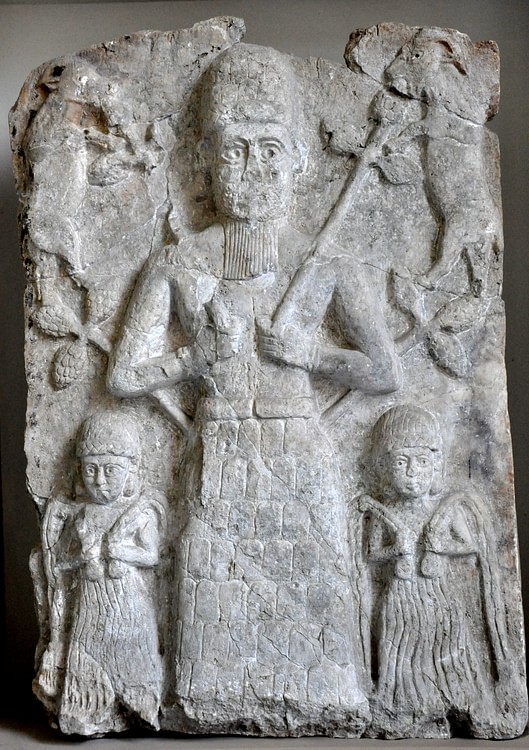
Assur (also Ashur, Anshar) is the god of the Assyrians who was elevated from a local deity of the city of Ashur to the supreme god of the Assyrian pantheon. The Assyrian Empire, like the later empire of the Romans, had a great talent for borrowing from other cultures. This penchant is illustrated clearly in the figure of Assur whose character and attributes draw on the Sumerian and Babylonian gods. Assur's family and history are modeled on the Sumerian Anu and Enlil and the Babylonian Marduk ; his power and attributes mirror Anu's, Enlil's, and Marduk's as do details of his family: Assur's wife is Ninlil (Enlil's wife) and his son is Nabu (Marduk's son). Assur had no actual history of his own, such as those created for Sumerian and Babylonian gods but borrowed from these other myths to create a supreme deity whose worship, at its height, was almost monotheistic. Scholar Jeremy Black notes:
In spite of (or possibly because of) the tendencies to transfer to him the attributes and mythology of other gods, Assur remains an indistinct deity with no clear character or tradition (or iconography) of his own. (38)
ASSUR HAD NO ACTUAL HISTORY OF HIS OWN BUT BORROWED FROM OTHER MYTHS TO CREATE A SUPREME DEITY WHOSE WORSHIP, AT ITS HEIGHT, WAS ALMOST MONOTHEISTIC.
Assur had power over the kingship of Assyria but, in this, was no different from Marduk of Babylon. The king of Assyria was his chief priest and all those who tended his temple in the city of Ashur and elsewhere lesser priests. Assyrian kings frequently chose his name as an element in their own to honor him ( Ashurbanipal, Ashurnasirpal I, Ashurnasirpal II, etc). Worship of Assur consisted, as with other Mesopotamian deities, of priests tending the statue of the god in the temple and taking care of the duties of the complex surrounding it. Although people may have engaged in private rituals honoring the god or asking for assistance, there were no temple services as one would recognize them in the modern day.
The iconography of Assur is often taken from the Sumerian Anu, a crown or a crown on a throne, but he is as frequently represented as a warrior-god wearing a horned helmet and carrying a bow and quiver of arrows. He wears a short skirt of feathers and is sometimes depicted within a winged disk (although the association of Assur with the solar disk is contested by a number of modern scholars, among them Jeremy Black). Assur is also sometimes represented standing on a snake-dragon, an image borrowed from the Babylonian Marduk, among other gods.
EARLY ORIGINS
Assur is first positively attested to in the Ur III Period (2047-1750 BCE) of Mesopotamian history. He is identified as the patron god of the city of Ashur c. 1900 BCE at its founding and also gives his name to the Assyrians. From a local, and probably agricultural, god who personified the city, Assur steadily acquired greater and greater attributes. The scholar EA Wallis Budge describes the general progression gods made from spirits to local deities to supreme gods:
The oldest of such spirits was the "house spirit" or household-god. When men formed themselves into village communities the idea of the "spirit of the village" was evolved and later came the "god of the town or city" and the "god of the country". Each of the elements, earth, air, fire, and water had its spirit or "god", the earthquake, lightning, thunder, rain, storm, desert whirlwind, each likewise its spirit or "god", and of course each plant, tree, and animal. As time went on, men began to think that certain spirits were more powerful than others and these they selected for special reverence or worship. (81-82)
Such was the case with Assur in that he is originally referenced as the god of only the locale surrounding the city but came to personify and represent the entire nation of Assyria. His city mirrored his rise to fame as Ashur began as a small trading center built on the site of an earlier community founded by Sargon of Akkad (2334-2279 BCE) but flourished through trade with Anatolia and with other regions of Mesopotamia to become the capital of Assyria by the time of the reign of the Assyrian king Shamashi Adad I (1813-1791 BCE). Shamashi Adad I drove the Amorites from the region in Assur's name and secured his boundaries but was defeated by the Amorite king Hammurabi of Babylon (1792-1750 BCE) who then controlled the region.Worship of Assur at this time was restricted to the city and the Assyrian lands surrounding it, while Marduk of Babylon was worshiped as the supreme god and the Babylonian work Enuma Elish was considered the authoritative piece on creation and the birth of the gods and humanity.
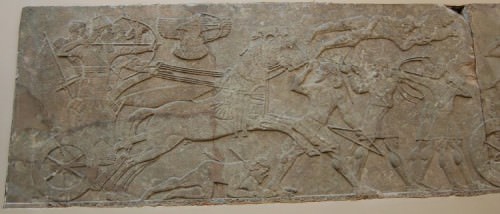
Ashurbanipal II Attacking Enemy Archers
RISE TO POWER
In the tumult following Hammurabi's death, different powers controlled the region and their gods were considered supreme.The Mitanni and the Hittites both held Ashur and Assyrian areas as a vassal state until they were defeated by king Adad Nirari I (1307-1275 BCE), who united the lands under the first semblance of an Assyrian empire. Assur is credited by the king as the god who granted him the victory, but no history of the god existed to glorify. Scholar Jeremy Black comments on this:
Eventually, with the growth of Assyria and the increase in cultural contacts with southern Mesopotamia, there was a tendency to assimilate Assur to certain of the major deities of the Sumerian and Babylonian pantheons.From about 1300 BCE we can trace some attempts to identify him with Sumerian Enlil. This probably represents an effort to cast him as the chief of the gods...Then, under Sargon II of Assyria (reigned 722-705 BCE), Assur tended to be identified with Anshar, the father of Anu (An) in the Babylonian Epic of Creation. The process thus represented Assur as a god of long-standing, present from the creation of the universe. (37-38)
From the time of Adad Nirari I to the time of the Neo-Assyrian Empire of Sargon II, Assur continued to rise in prominence. In the Enuma Elish, Assur (under the name Anshar) replaced Marduk as the hero. Tiglath Pileser I (1115-1076 BCE) regularly invokes Assur as the god of the empire who empowers the army and leads them to victory and even credits Assur with the laws of the empire. Adad Nirari II (912-891 BCE) expanded the empire in every direction with Assur as his personal patron.Everywhere the Assyrian army traveled, Assur traveled with them, and thus his worship spread across Mesopotamia. Wallis Budge writes, "As the power of Marduk became predominant when Babylon grew into a great city, so the power of Assur waxed great when the Assyrians became a strong and warlike nation" (88). To the men who marched in the Assyrian forces, as well as to those they conquered, Assur was obviously a powerful god worthy of worship and devotion and, in time, he became so powerful as to eclipse the earlier gods of the region.
ASSUR, THE SUPREME GOD
When Ashurnasirpal II (884-859 BCE) came to power, he moved the capital of the empire from Ashur to the city of Kalhu, but this is no indication of waning power on Assur's part; Ashurnasirpal II had Assur's name as part of his own (his name means 'Assur is Guardian of the Heir'). The reason for the capital's move is unclear, but most likely it was only because Ashur had grown so great and the populace fiercely proud and Ashurnasirpal II wanted to surround himself with humbler and more easily manageable people. Tiglath Pileser III (745-727 BCE) elevated Assur's name even higher through the stunning victories which marked his reign. Tiglath Pileser III created the first professional army in the history of the world, who, armed with iron weapons, were invincible. Along with the new kind of army, new technology was created such as siege engines which allowed the army to take whole cities with fewer losses.
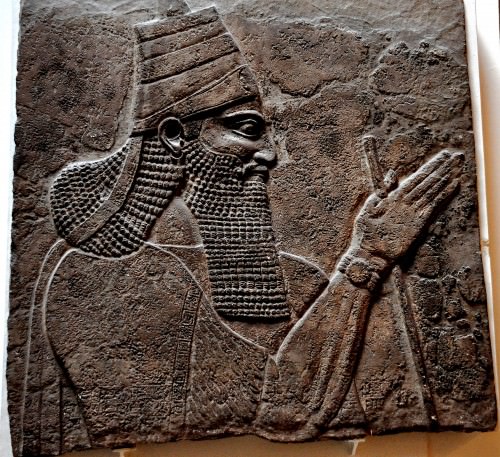
King Tiglath-pileser III
As the Assyrian armies campaigned throughout the land, Assur led them to greater and greater victories. Previously, however, Assur had been linked with the temple of the city of Ashur and had only been worshiped there. As the Assyrians made wider and wider gains in territory, a new way of imagining the god became necessary in order to continue that worship in other locales. Scholar Paul Kriwaczek explains how, in order to maintain worship of Assur, the nature of a god - and how that god should be understood and worshiped - had to change:
One might pray to Assur not only in his own temple in his own city, but anywhere. As the Assyrian empire expanded its borders, Assur was encountered in even the most distant places. From faith in an omnipresent god to belief in a single god is not a long step. Since He was everywhere, people came to understand that, in some sense, local divinities were just different manifestations of the same Assur. (231)
This unity of vision of a supreme deity helped to further unify the regions of the empire. The different gods of the conquered peoples and their various religious practices became absorbed into the worship of Assur, who was recognized as the one true god who had been called different names by different people in the past but who now was clearly known and could be properly worshiped as the universal deity. Regarding this, Kriwaczek writes:
Belief in the transcendence rather than immanence of the divine had important consequences. Nature came to be desacralized, deconsecrated. Since the gods were outside and above nature, humanity – according to Mesopotamian belief created in the likeness of the gods and as servant to the gods – must be outside and above nature too. Rather than an integral part of the natural earth, the human race was now her superior and her ruler.The new attitude was later summed up in Genesis 1:26: 'And God said, Let us make man in our image, after our likeness: and let him have dominion over the fish of the sea, and over the fowl of the air, and over the cattle, and over all the earth, and over every creeping thing that creepeth upon the earth' That is all very well for men, explicitly singled out in that passage. But for women it poses an insurmountable difficulty. While males can delude themselves and each other that they are outside, above, and superior to nature, women cannot so distance themselves, for their physiology makes them clearly and obviously part of the natural world…It is no accident that even today those religions that put most emphasis on God's utter transcendence and the impossibility even to imagine His reality should relegate women to a lower rung of existence, their participation in public religious worship only grudgingly permitted, if at all. (229-230)
Women in Mesopotamia had enjoyed almost equal rights with men until the rise of Hammurabi and his god Marduk. Under Hammurabi's reign, female deities began to lose prestige as male gods became increasingly elevated. Under Assyrian rule, with Assur as supreme god, women's rights suffered further. Cultures like the Phoenicians, who had always regarded women with great respect, were forced to follow the customs and beliefs of the conquerors. The Assyrian culture became increasingly cohesive with the expansion of the empire, the new understanding of the deity, and the assimilation of the people from the conquered regions. Shalmaneser III (859-824 BCE) expanded the empire up through the coast of the Mediterranean and received regular tribute from wealthy Phoenician cities such as Tyre and Sidon.
Assur was now the supreme god not only of the Assyrians but of all those people who were brought under their rule. To the Assyrians, of course, this was an ideal situation, but this opinion was not shared by every nationality they had conquered, and when the opportunity presented itself, they would vent their frustrations dramatically.
THE END OF ASSUR
The Neo-Assyrian Empire (912-612 BCE) is the last expression of Assyrian political power in Mesopotamia and is the one most familiar to students of ancient history. The kings of this period are the ones most often mentioned in the Bible and best known by people in the present day. It is also the era which most decisively gives the Assyrian Empire the reputation it has for ruthlessness and cruelty. Kriwaczek comments on this, writing :
Assyria must surely have among the worst press notices of any state in history. Babylon may be a byname for corruption, decadence and sin but the Assyrians and their famous rulers, with terrifying names like Shalmaneser, Tiglath-Pileser, Sennacherib, Esarhaddon and Ashurbanipal, rate in the popular imagination just below Adolf Hitler and Genghis Khan for cruelty, violence, and sheer murderous savagery. (208)
Although there is no denying the Assyrians could be ruthless and were quite clearly not to be trifled with, they were really no more savage or barbaric than any other ancient civilization. In order to form and maintain an empire, they destroyed cities and murdered people, but in this, they were no different from those who preceded and followed them, save in that they were easily more efficient than most.

Assyrian Deportation of People from Southern Iraq
To the conquered people, however, the Assyrians were seen as hated overlords. The last great king of the empire was Ashurbanipal (668-627 BCE) and, after him, the empire began to break apart. There were many reasons for this but, mainly, it had simply grown too large to manage. As the power of the central government became less and less able to cope, more territories broke away from the empire. In 612 BCE a coalition of Babylonians, Medes, Persians, and others rose against the Assyrian cities and destroyed them. Included in this onslaught was the city of Ashur and the temple of the god as well as other statues of Assur elsewhere. Assur had come to personify the Assyrians, their military victories, and their political power, and so the destruction of this symbol was of special importance to Assyria's enemies.
Worship of Assur continued in Assyrian communities after the fall of the empire but was no longer widespread and no temples, shrines, or statuaries were left standing in the cities and regions which had revolted. In the early Christian era, the understanding of Assur as an omnipotent deity worked well for the early Christian missionaries to the region, who found the Assyrians receptive to their message of a single god and the concept of this god's son coming to earth for the benefit of humanity. Although Assur's son Nabu never became incarnated or sacrificed himself for others, he was thought to have given human beings the gift of the written word. Nabu continued to be venerated after the fall of the empire, and although Assur declined in stature, he was remembered and is still present (often as Ashur) as a personal and family name in the present day.
Esarhaddon › Who Was
Definition and Origins
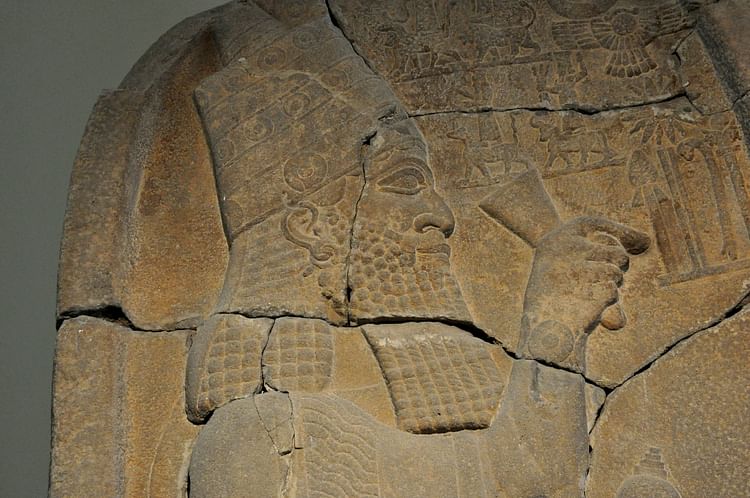
Esarhaddon (reigned 681-669 BCE) was the third king of the Sargonid Dynasty of the Neo-Assyrian Empire. He was the youngest son of King Sennacherib (reigned 705-681 BCE), and his mother was not the queen but a concubine named Zakutu(also known as Naqia-Zakutu, c.701-668 BCE). Esarhaddon is mentioned in the Bible in II Kings 19:37, Isaiah 37:38, and Ezra 4:2. He is best known for re-building Babylon (which his father had destroyed) and for his military campaigns in Egypt. An avid follower of astrology, he consulted oracles on a regular basis throughout his reign, far more than any other Assyrian king.He claimed the gods had ordained him to restore Babylon and cleverly omitted from his inscriptions anything that would implicate Sennacherib in the city ’s fall. In his other diplomatic letters he seems equally careful and maintained, then enlarged, the empire his father had left to him. He died on campaign in Egypt and left the throne to his son, Ashurbanipal.
ASCENT TO THE THRONE
Sennacherib had over eleven sons with his various wives and chose as heir his favorite, Ashur -nadin-shumi, the eldest of those born of his queen. He appointed Ashur-nadin-shumi to rule over Babylon and, while fulfilling his duties, the prince was kidnapped by the Elamites and taken to Elam. Sennacherib mounted an enormous expedition to retrieve his son but was defeated. It is thought that Ashur-nadin-shumi was then killed by his captors sometime around 694 BCE. After the defeat of the Assyrian army by the Elamite coalition, Sennacherib returned to his capital at Nineveh and busied himself with building projects and running his empire. He needed to choose a new heir but seems to have taken his time in deciding who that would be. It could be that, during this time, he was evaluating his sons, or it could simply be that he was still grieving the loss of his favorite and did not wish to replace him. In any case, it was not until 683 BCE that Sennacherib declared Esarhaddon heir.
HE REBUILT THE ENTIRE CITY: TEMPLES, HOMES, AND STREETS. AND TO MAKE SURE EVERYONE WOULD REMEMBER THEIR BENEFACTOR, INSCRIBED THE BRICKS AND STONES WITH HIS NAME.
His older brothers did not take the news well. In Esarhaddon's inscriptions he writes:
Of my older brothers, the younger brother was IBut by decree of [the gods] Ashur and Shamash, Bel and Nabu
My father exalted me, amid a gathering of my brothers:
He asked Shamash, “Is this my heir?”
And the gods answered, “He is your second self.”
And then my brothers went mad.
They drew their swords, godlessly, in the middle of Nineveh.
But Ashur, Shamash, Bel, Nabu, Ishtar,
All the gods looked with wrath on the deeds of these scoundrels,
Brought their strength to weakness and humbled them beneath me.
While his inscription tells the basic story, it is not the whole one. It appears that, after Sennacherib announced his choice, the brothers made clear their displeasure and Zakutu sent Esarhaddon into hiding. Exactly where he went is unknown, but it was somewhere in the region formerly held by the Mitanni. In c. 689 BCE Sennacherib had sacked and destroyed the city of Babylon, carrying off the statue of the great god Marduk, and this had not met with the approval of the Assyrian court or the people of the empire. Babylon and Assyria shared many of the same gods, and an affront to Marduk of Babylon was a sacrilege which could not be tolerated. In 681 BCE Sennacherib was assassinated by two of his sons. While they certainly could have been motivated to kill him to take the throne (and so cut Esarhaddon off from his inheritance), they would have required some form of justification, and the destruction of Babylon would have served that purpose well. Their names are not known outside of the biblical versions given in II Kings 19 and Isaiah 37:38 where they are called Adrammelech and Sharezer.Following the assassination, the two princes fled Nineveh and sought refuge with the king of Urartu, Rusas II.
At this point Esarhaddon was re-called from exile and fought his brother's factions for the throne. After a six-week civil war, he emerged victorious, executed his brother's families, associates, and all who had joined their cause, and took the throne.
REIGN & RESTORATION OF BABYLON
Among his first decrees was the restoration of Babylon. In his inscription he writes:
Great king, mighty monarch, lord of all, king of the land of Assur, ruler of Babylon, faithful shepherd, beloved of Marduk, lord of lords, dutiful leader, loved by Marduk's Consort Zurpanitum, humble, obedient, full of praise for their strength and awestruck from his earliest days in the presence of their divine greatness [am I, Esarhaddon].When in the reign of an earlier king there were ill omens, the city offended its gods and was destroyed at their command. It was me, Esarhaddon, whom they chose to restore everything to its rightful place, to calm their anger, to assuage their wrath. You, Marduk, entrusted the protection of the land of Assur to me. The Gods of Babylon meanwhile told me to rebuild their shrines and renew the proper religious observances of their palace, Esagila. I called up all my workmen and conscripted all the people of Babylonia. I set them to work, digging up the ground and carrying the earth away in baskets (Kerrigan, 34).
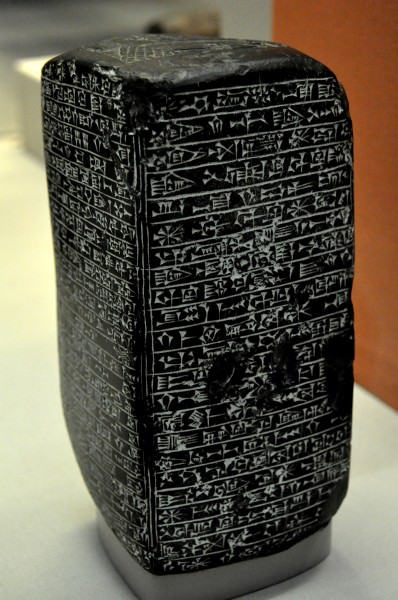
Stone Monument of Esarhaddon
Esarhaddon carefully distanced himself from his father's reign and, especially, from the destruction of Babylon. Even though he identifies himself as the son of Sennacherib and grandson of Sargon II in other inscriptions, in order to make clear that he is the legitimate king, in his inscriptions concerning Babylon he is simply the king whom the gods have ordained to set things right. Sennacherib is only referenced as “an earlier king” in a former time. The propaganda worked, in that there is no record that he was associated in any way with the destruction of the city, only with the re-building. His inscriptions also claim that he personally participated in the restoration project. The historian Michael Kerrigan comments on this, writing :
Esarhaddon believed in leading from the front, taking a central role in what we nowadays call the `groundbreaking ceremony' for the new Esagila. Once the damaged temple had been demolished and its site fully cleared, he says, “I poured libations of the finest oil, honey, ghee, red wine, white wine, to instil respect and fear for the power of Marduk in the people. I myself picked up the first basket of earth, raised it on to my head, and carried it” (35).
He rebuilt the entire city, from the temples to the temple complexes to the homes of the people and the streets and, to make sure everyone would remember their benefactor, inscribed the bricks and stones with his name. The historian Susan Wise Bauer writes:
He wrote his own praises into the very roads underfoot: scores of the bricks that paved the approach to the great temple complex of Esagila were stamped, “For the god Marduk, Esarhaddon, king of the world, king of Assyria and Babylon, made the processional way of Esagila and Babylon shine with baked bricks from a ritually pure kiln (401).
Although the prophecies concerning the re-building of Babylon had said that the city would not be restored for 70 years, Esarhaddon manipulated the priests to read the prophecy as eleven years. He did this by having them read the cuneiformnumber for 70 upside down so that it meant eleven, which was exactly the number of years he had planned for the restoration.Since he maintained a life-long interest in astrology and prophecy, it has seemed strange to some scholars that he would manipulate the priests in this way and discredit the integrity of the oracles. It seems clear, however, that he had a very clear vision for his reign and, even though he did believe in the signs from the gods, he was not going to allow that belief to stand in the way of achieving his objectives.
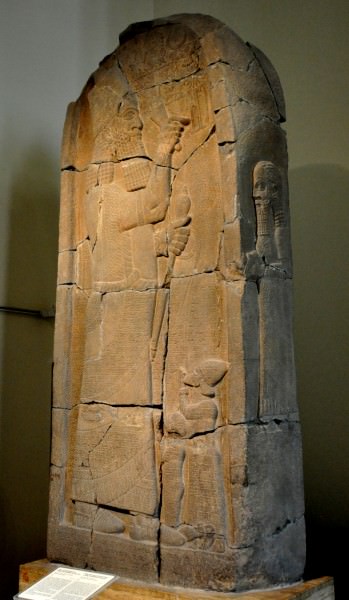
Sam'al Stele of King Esarhaddon
MILITARY CAMPAIGNS
With Babylon restored, Esarhaddon set about expanding and improving upon his empire. The Cimmerians, a nomadic tribe of the north, were threatening his western borders, and the Kingdom of Urartu, which his grandfather had defeated in 714 BCE, had risen again in the north. His two brothers, who had killed their father, were still there under the protection of King Rusas II who, like the Urartu kings before him, had no love for the Assyrians. In order to keep the Cimmerians at bay, Esarhaddon entered into a treaty with the Scythians, another nomadic tribe known for their skill in cavalry warfare. Although he felt he needed their help, he did not trust them as allies. Esarhaddon consulted his oracles regarding Urartu, the Cimmerians, and the Scythians, and his questions are preserved on divination tablets (prayers or requests inscribed on tablets which were then read in the temple in the presence of the god). Two of his tablets read:
Shamash, great lord, will Rusas, king of the Urartu, come with his armies, and the Cimmerians (or any of his allies), and wage war, kill, plunder, and loot?Shamash, great lord, if I give one of my daughters in marriage to the king of the Scythians, will he speak words of good faith to me, true and honest words of peace? Will he keep my treaty and do whatever is pleasing to me?
While Esarhaddon was consulting the oracles, the Cimmerians invaded from the west in 679 BCE. By 676 BCE they had fought their way further into Assyrian-held lands and conquered Phrygia (roughly modern-day Turkey ), destroying the citiesand temples. Esarhaddon met the Cimmerians in battle at Cilicia and defeated them. He claims in his inscriptions to have killed their king, Teushpa, with his own sword.
At the same time the Cimmerians had invaded, the city of Sidon in the Levant rebelled against Assyrian rule and Esarhaddon marched down the coast of the Mediterranean Sea, defeated the rebel king, and executed him. He then turned about and marched against the allies of Urartu, the Mannaeans, to the north-east and, by early 673 BCE, was at war with Urartu itself.What happened to his brothers is unknown, but Urartu was again beaten back by the Assyrian army and, if the brothers were still alive when Esarhaddon defeated the Urartu, he would no doubt have had them executed.
THE EGYPTIAN CAMPAIGNS & DEATH
Having now secured his borders, Esarhaddon thought to expand them. Egypt had been a problem for the Assyrians in his father's reign and was still encouraging dissent and revolt in the Assyrian Empire. In 673 BCE Esarhaddon launched his first military campaign against Egypt and, thinking to storm Egypt in one furious push, marched his army at great speed. This proved to be a mistake. When they met the Egyptian forces under the Kushite Pharaoh Tirhakah outside the city of Ashkelon, the Assyrians were exhausted and quickly defeated. Esarhaddon withdrew from the field and his army limped back to Nineveh.
Esarhaddon learned from his mistake and, in 671 BCE, took his time and brought a much larger army slowly down through Assyrian territory and up to the Egyptian borders; then he ordered the attack. The Egyptian cities fell quickly to the Assyrians and Esarhaddon drove the army forward down the Nile Delta and captured the capital city of Memphis. Although Tirhakah escaped, Esarhaddon captured his son, wife, family, and most of the royal court and sent them, along with much of the population of Memphis, back to Assyria. He then placed officials loyal to him in key posts to govern his new territory and returned to Nineveh. His victory is commemorated on his famous Victory Stele of 671 BCE now in the Pergamon Museum of Berlin, Germany. The stele depicts Esarhaddon in his full majesty, holding a war mace, with an attendant king kneeling at his feet and Tirhakah's son, also kneeling abjectly, with a rope around his neck.
His eldest son and heir, Sin-iddina-apla, had died in 672 BCE, and Esarhaddon now chose his second son, Ashurbanipal, as his successor. He forced his vassal states to swear loyalty in advance to Ashurbanipal in order to avoid any revolts over the future succession. At about this same time, Esarhaddon's mother Zakutu issued the Loyalty Treaty of Naqia-Zakutu which compelled the Assyrian court and those territories under Assyrian rule to accept and support the reign of Ashurbanipal. In order to avoid the kind of conflict he had gone through with his brothers, Esarhaddon also provided for his youngest son, Shamash-shun-ukin, by decreeing he should be king of Babylon.
Esarhaddon seems to have just finished setting his affairs in order when news reached him that Egypt had rebelled. Many of the trusted officials he had left in charge of cities and provinces had become sympathetic to Egyptian liberation and, no doubt, were profiting handsomely from their positions and were disinclined to send tribute back to Nineveh. In 669 BCE, Esarhaddon mobilized his army and marched again on Egypt; he died before he reached the borders. It would be left to Ashurbanipal to complete his father's work and conquer Egypt for the Assyrian Empire.
See other Related Contents ››
LICENSE:
Article based on information obtained from these sources: with permission from the Website Ancient History Encyclopedia
Content is available under License Creative Commons: Attribution-NonCommercial-ShareAlike 3.0 Unported. CC-BY-NC-SA License